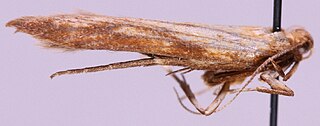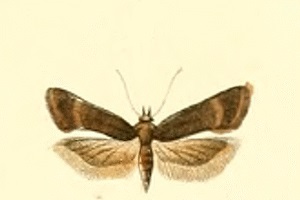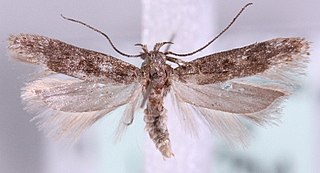
Pseudotelphusa scalella is a moth of the family Gelechiidae. It is found from most of Europe to the southern Ural and the Volga region. It is also found in Turkey.
Caryocolum huebneri is a moth of the family Gelechiidae. It is found in most of Europe, except Ireland, the Netherlands, the Iberian Peninsula, Norway, Finland, Estonia, Lithuania, and most of the Balkan Peninsula. In the east, the range extends to the Ural Mountains.

Aristotelia subericinella is a moth of the family Gelechiidae. It is found in southern and eastern Europe, The Ural Mountains, Turkey and Central Asia.
Atremaea lonchoptera is a moth of the family Gelechiidae. It is found in large part of Europe, except Ireland, Great Britain, the Iberian Peninsula, Switzerland, Belgium, Fennoscandia, the Baltic region and the western Balkan Peninsula. It is also found in Russia.

Chionodes electella is a moth of the family Gelechiidae. It is found in almost all of Europe. In the east, the range extends to the southern Ural.
Lutilabria is a genus of moths in the family Gelechiidae.
Megacraspedus separatellus is a moth of the family Gelechiidae. It is found from central and southern Europe to the Ural Mountains. Outside Europe it is found in the Altai Mountains, Turkey and the Caucasus.

Xystophora pulveratella is a moth of the family Gelechiidae. It is found from central and northern Europe to the Ural Mountains and southern Siberia.

Metzneria neuropterella, the brown-veined neb, is a moth of the family Gelechiidae. It is found from most of Europe to the southern Ural Mountains, the Caucasus, southern and south-eastern Siberia and Mongolia, as well as in North Africa. The habitat consist of short-turfed, herb rich chalk downland.
Metzneria artificella is a moth of the family Gelechiidae. It is found from southern and eastern Europe to the southern Ural and the Volga region. It is also found in Iran and southern Siberia.

Ptocheuusa abnormella is a moth of the family Gelechiidae. It is found from central and southern Europe to the Ural Mountains.

Monochroa sepicolella is a moth of the family Gelechiidae. It is found from central and northern Europe to the Ural Mountains, the Caucasus and southern Siberia.

Monochroa simplicella is a moth of the family Gelechiidae. It is found in Russia, Belarus, Slovakia, Germany, Italy, Hungary, Finland and the Baltic region. Outside of Europe, it is found in the Altai and in Irkutskaya oblast.

Monochroa ferrea is a moth of the family Gelechiidae. It is found from central and northern Europe to the southern Ural. Outside of Europe, it is found in Transbaikalia and the Altai region.
Monochroa parvulata is a moth of the family Gelechiidae. It is found from southern and central Europe to Estonia in the north and the southern Ural in the east.

Gelechia rhombella, the apple groundling, is a moth of the family Gelechiidae. It is found in Europe, the Caucasus, Transcaucasia, southern Siberia, the Russian Far East, Korea and China.
Gelechia basipunctella is a moth of the family Gelechiidae. It is found in from central Europe to Russia, Turkey and Mongolia.

Filatima spurcella is a moth of the family Gelechiidae. It is found from central and southern Europe to the southern Ural and Turkey.

Scrobipalpa salinella, the sea-aster groundling, is a moth of the family Gelechiidae. It is found Europe, along the coast and in inland halophytic habitats. In the east, the range extends through Siberia and Central Asia to Mongolia. It is also found in North Africa.
Lutilabria volgensis is a moth in the family Gelechiidae. It was described by Anikin and Piskunov in 1996. It is found in Russia.











